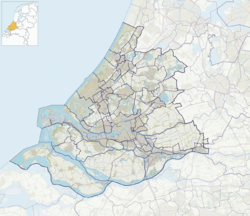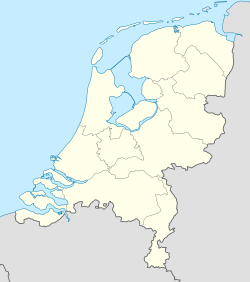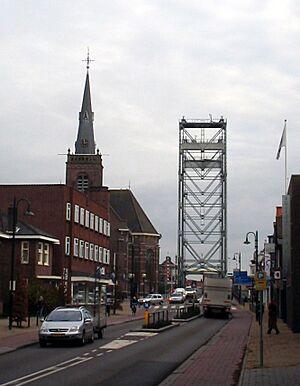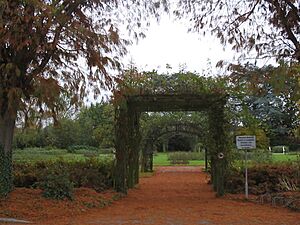Boskoop facts for kids
Quick facts for kids
Boskoop
|
|||
|---|---|---|---|
|
Town and former municipality
|
|||
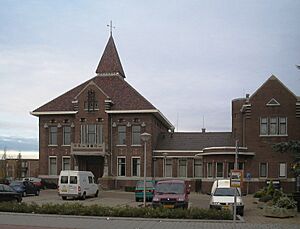
Former Boskoop city hall
|
|||
|
|||
| Country | Netherlands | ||
| Province | South Holland | ||
| Municipality | Alphen aan den Rijn | ||
| Area | |||
| • Total | 7.29 km2 (2.81 sq mi) | ||
| • Land | 5.91 km2 (2.28 sq mi) | ||
| • Water | 1.39 km2 (0.54 sq mi) | ||
| Elevation | −2 m (−6.6 ft) | ||
| Population
(2021)
|
|||
| • Total | 16,325 | ||
| • Density | 2,239.4/km2 (5,800/sq mi) | ||
| Time zone | UTC+1 (CET) | ||
| • Summer (DST) | UTC+2 (CEST) | ||
| Postcode |
2770–2771
|
||
| Area code | 0172 | ||
Boskoop is a town in the South Holland province of the Netherlands. It used to be its own municipality. In 2014, it joined with Alphen aan den Rijn.
Boskoop is famous for its many plant nurseries. A nursery is a place where plants are grown for sale. It is known as the world's largest combined area for growing flowers and plants. About 774 nurseries are found here. They are on long pieces of land, separated by narrow canals.
Before World War II, most goods were moved by small boats on these canals. Some very tall footbridges still stand today. These bridges cross the wider main canals. Over time, Boskoop changed from growing fruit to growing decorative garden plants and trees. It is still famous worldwide for its knowledge of growing beautiful plants.
The name "Boskoop" has been given to several plants. These include an apple called 'Belle de Boskoop'. There is also a grape called 'Boskoop Glory'. Other plants named after the town are a type of Calluna and Weigela, and a blackcurrant called 'Boskoop Giant'.
Contents
Exploring Boskoop's Location
Boskoop is in a special green area called the "Green Heart." This area is inside the busy "Randstad" region of the Netherlands. The town sits on both sides of the Gouwe River. To the north is Alphen aan den Rijn, and to the south is Waddinxveen.
The town is also bordered by Reeuwijk and Bodegraven to the east. To the west, it borders Rijnwoude. A special vertical-lift bridge in the town center connects the two sides of the Gouwe River.
A Look Back at Boskoop's History
It is believed that Boskoop started as a settlement called Ten Bussche. This was founded by William I, Count of Holland, in 1204. In 1222, the Abbey of Rijnsburg became the owner of Boskoop. The Abbey decided to grow more trees and shrubs. They asked farmers to grow extra trees beyond their own needs.
From the 1400s to the 1600s, more and more trees were grown. Decorative plants were also introduced. By the late 1800s, Boskoop began sending its plants to other countries. Germany was its first customer.
Boskoop's history was shaped by its thick layer of peat. Peat is a type of soil made from decayed plants. When the Abbey of Rijnsburg owned Boskoop, people started digging up peat for fuel. But Boskoop was far from big cities, so digging peat was not very profitable. Also, the Abbey did not allow too much peat to be dug up. Because of this, Boskoop still has rich soil for farming and growing plants.
A challenge for growing plants was the high groundwater level. Water was often very close to the surface. To solve this, many canals and ditches were dug to drain rainwater. At one point, there were about 2,000 kilometers of these waterways! This meant that much of the transport was done by boat.
Later, new ways to drain water were found. This lowered the groundwater level. Many ditches could then be filled in. However, even today, many canals remain in Boskoop. Nurseries still use them for transport. Because of its many waterways, Boskoop is sometimes called "Small Giethoorn" (another Dutch town known for its canals).
Today, most plants are grown in pots instead of in the open ground. They are then sent directly to auctions. The plant nursery business in Boskoop faces challenges. Nurseries are often small, and it's hard to use large machines. Also, land and labor costs are high.
The municipality of Boskoop faced financial difficulties for several years. This was partly due to the high cost of maintaining roads that kept sinking. Because of these challenges, Boskoop merged into Alphen aan den Rijn. This happened on January 1, 2014.
Getting Around Boskoop
Boskoop has two train stations. These are Boskoop railway station and Boskoop Snijdelwijk railway station. The trains connect Boskoop to the RijnGouweLijn. This line runs from Alphen aan den Rijn to Gouda. Trains run every thirty minutes in both directions. During busy times, extra trains run towards Gouda and Leiden.
Fun Things to See in Boskoop
The vertical-lift bridge in Boskoop is one of three similar bridges over the Gouwe River. The other two are in Alphen aan den Rijn and Waddinxveen. This bridge is in the center of the village and is a key part of its skyline. A new bike path was added to the bridge when it was fixed up in the early 1990s.
Another old building is the Water Tower of Boskoop. It is on the northeast side of the village. It is on the same road that crosses the lift bridge.
Near the train station, there is a large rose garden called a rosarium. You can visit it for free all year round. More than 160 types of roses are displayed here. You can also see many other shrubs, trees, and plants.
Boskoop also has a nursery museum, which makes sense given its history. It is located in an old nursery home from 1870. Behind the museum, there is another rose garden. This garden features rose types from the 1600s to the 1900s.
From spring to fall, you can take boat tours through Boskoop's many canals. These tours go past nurseries and natural areas. They also share information about Boskoop's history and surroundings. Once a year, a special nursery canoe tour is organized.




